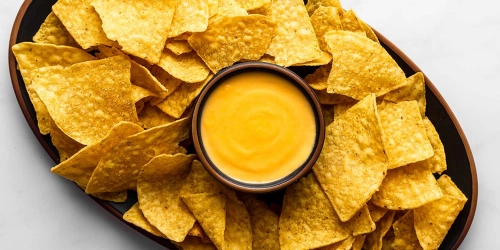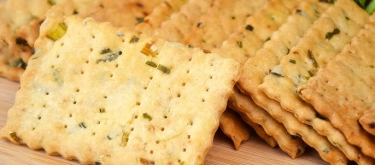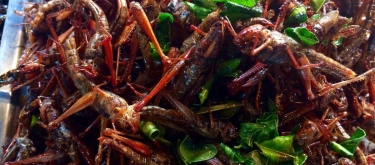Nachos: Taste Profile, Aroma, Benefits and Health Risks
Nachos are a popular Mexican-origin snack made from corn tortilla chips topped with melted cheese and various ingredients such as salsa, jalapeños, beans, guacamole, and sour cream. Originally created in the 1940s in northern Mexico, nachos have evolved into a global comfort food—served everywhere from street stalls to restaurants and home gatherings.
Nachos commonly contain dairy (cheese), gluten (in some commercial corn chips), and potential allergens like soy or preservatives from sauces. They are high in sodium and fat, especially when topped with cheese or meat. People with lactose intolerance, celiac disease, or hypertension should consume in moderation. Pregnant women should avoid unpasteurized cheese toppings.
What does Nachos taste like?

Complete Sensory Description
-
Taste: The first crunch delivers a combination of roasted corn sweetness and salt, followed by creamy cheese richness. Mid-palate, spiciness from jalapeños and tang from salsa emerge, layered with savory umami from melted cheese or seasoned meat. The finish blends salt, spice, and a lingering corn-toasty aftertaste.
-
Aroma: Retronasal aroma combines toasted corn, molten cheese, and tangy tomato notes, occasionally accented by cumin, chili, or lime.
-
Texture: Crispy at first bite, then creamy and soft where cheese and sauces meet. The ideal nacho maintains a balance between crunch and melt.
-
Appearance: Golden-yellow chips layered with melted cheese, colorful toppings like red salsa, green jalapeños, and white sour cream, creating a vibrant and appetizing presentation.
In-depth Flavor Analysis
Nacho flavor complexity arises from Maillard browning during chip frying, lactic fermentation in cheese, and acidic balance from salsa.
-
Key compounds:
-
Pyrazines and aldehydes (roasted, nutty notes from toasted corn)
-
Lactic acid and diacetyl (creamy, buttery notes from cheese)
-
Capsaicin (spiciness from chili)
-
Citric and acetic acids (freshness from lime or salsa)
-
-
Flavor levers: Temperature amplifies aroma release; fresh lime enhances brightness; controlled cheese-melt temperature prevents greasy bitterness.
-
Processing effects: Over-fried chips intensify bitterness; baked versions emphasize grain sweetness; different cheeses (cheddar, Monterey Jack) change richness and mouthfeel.
Varieties and Culinary Applications
-
Varieties:
-
Classic Nachos: Corn chips with melted cheddar and jalapeños.
-
Loaded Nachos: Topped with beans, ground beef, salsa, and sour cream.
-
Vegetarian Nachos: Includes avocado, black beans, and fresh herbs.
-
Dessert Nachos: Sweet tortilla chips with chocolate or caramel drizzle.
-
-
Applications: Served as appetizers, bar snacks, or shared platters. Mini-versions appear in tapas and food festivals, while healthier versions use baked chips and low-fat cheese.
Selection and Storage
-
Selection: Choose thick, whole chips without breakage for better topping support. Fresh toppings should be vibrant and aromatic.
-
Storage: Store plain tortilla chips in airtight containers to preserve crispness. Once assembled, nachos should be eaten immediately; reheating causes sogginess.

Nutritional Insights
Nachos provide carbohydrates from corn, protein and calcium from cheese, and fiber from beans or vegetables. However, they are energy-dense and high in saturated fat and sodium. Homemade or baked versions are significantly healthier.
Expert Insights & Culinary Tips
Chefs recommend layering nachos instead of piling to distribute heat and flavor evenly. Use two cheeses—one for melt (Monterey Jack) and one for flavor (cheddar). Adding a squeeze of lime or a spoon of fresh salsa enhances freshness and reduces perceived greasiness.
Interesting and Curious Facts
The dish was invented by Ignacio “Nacho” Anaya in 1943 in Piedras Negras, Mexico. He served tortilla chips with melted cheese and sliced jalapeños to American visitors—thus creating “Nachos Especiales.” Today, October 21 is celebrated as International Nacho Day.
Harm and Dietary Considerations
-
High sodium and saturated fat may raise cardiovascular risk.
-
Processed cheese toppings may contain artificial additives.
-
Fried chips contribute to calorie overload.
-
People with lactose intolerance should use vegan or lactose-free cheese substitutes.
Religious Dietary Considerations
-
Islam: Halal if no pork or alcohol-containing sauces are used.
-
Judaism: Kosher if made with kosher-certified cheese and meat.
-
Christianity: Generally unrestricted.
-
Hinduism & Buddhism: Vegetarian nachos without meat or gelatin are acceptable.
Final Thoughts & Sensory Journey
Nachos deliver contrast in every bite: crisp corn, molten cheese, tangy salsa, and spicy heat. Their appeal lies in balance—comfort food that’s indulgent yet communal, best shared and eaten warm.
Resources
-
McGee H. On Food and Cooking: The Science and Lore of the Kitchen. Scribner, 2004. ISBN: 9780684800011
-
Coultate TP. Food: The Chemistry of Its Components. Royal Society of Chemistry, 2016. ISBN: 9781782626483
-
Belitz HD, Grosch W, Schieberle P. Food Chemistry. Springer, 2009. ISBN: 9783540699330
-
Smith A. The Oxford Companion to American Food and Drink. Oxford University Press, 2013. ISBN: 9780195387104




